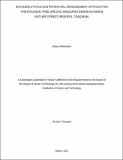| dc.description.abstract | Invasion of Maesopsis eminii in Amani Nature Forest Reserve was considered an ecological
disaster in the 1980s. After more than 50 years have elapsed since its introduction, there is
little information available on its invasion progress, germination and earlier growth
behavior. The present study resurveyed 60 (20 m × 50 m) sample plots previously surveyed
in 1998 and collected remote sensing data for 1997 and 2018. The effect of four shade levels
(0%, 50%, 65% and 85%) on seed germination and early growth of M. eminii seeds were
studies. Also information on the distribution of M. eminii species in household farms were
gathered through interviews and observation. Out of 30 control plots, M. eminii had invaded
seven new sample plots (23%) which were not invaded in 1998. Change detection analysis
indicated 1108 ha of non-forest vegetation had regrown into forest over the last 20 years,
particularly in the south - western region of the reserve. The study found that the average
germination rate across the four different shade levels differed significantly during the dry
season (F
(3,12) =
48.74, P < 0.001) but not during wet season (F
(3,12)
= 3.49, P = 0.051).
During the dry season, leaf chlorophyll contents were three times higher at 65% and 85%
shade than at 0% shade level. Also this study found that 58% of household farms had M
eminii. There was significant negative association (ρ = -0.49, P = <0.001) between
population size of M. eminii in household farms and the distance from the forest reserve
boundary. Majority of respondents (68%) demonstrated good understanding of M. eminii
while it was further found positive correlation between respondents‟ age and knowledge on
M. eminii invasion. (ρ = 0.49, P = <0.001). The study concludes that there is 4% increase in
spatial distribution of M. eminii between 1998 and 2018, with higher M. eminii density in
invaded plots than control plots. Based on this study, it is recommended that potential
management options to take into account light and water availability regimes to predict
susceptible forest niches and prevent further spread of Maesopsis eminii. | en_US |

